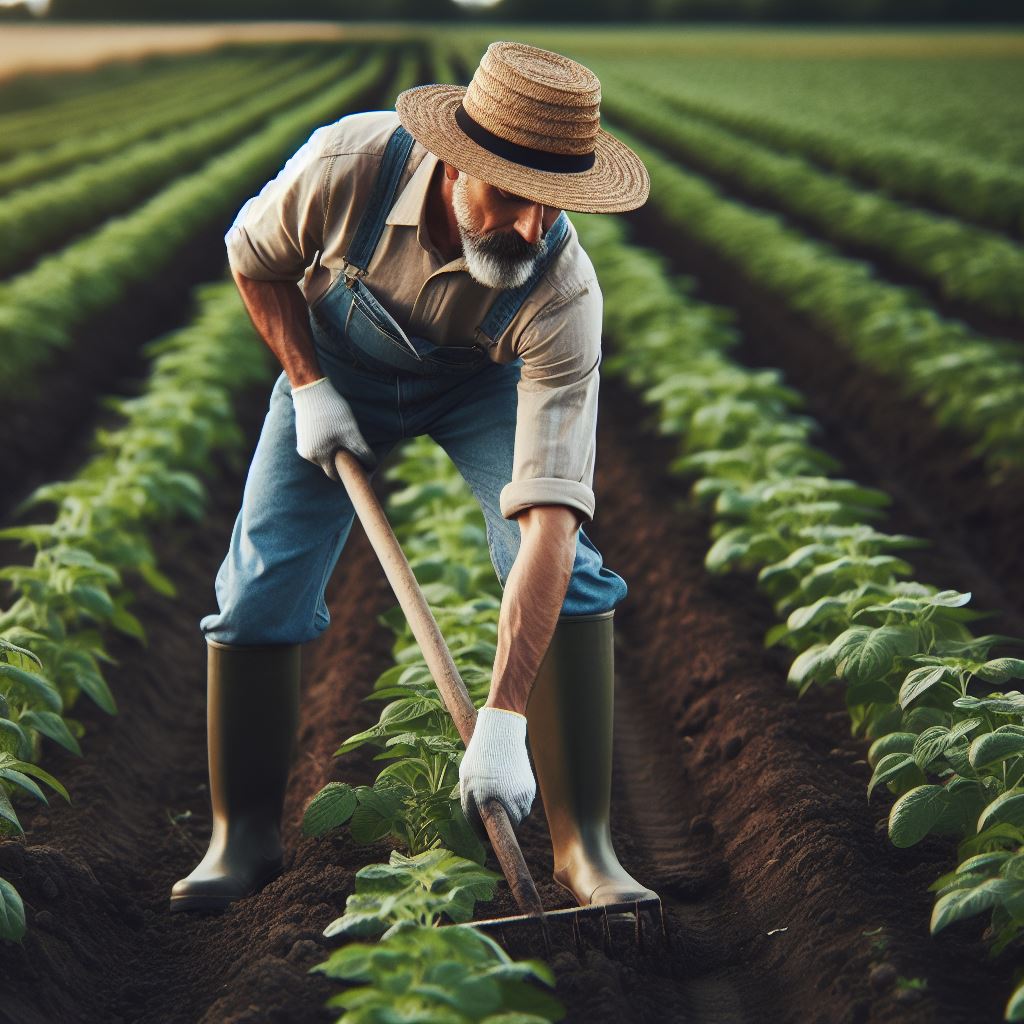Introduction
Brief explanation of high-tech farming
In high-tech farming, advanced technology is used to improve agricultural practices and increase productivity.
Climate resilience is crucial in farming as it helps farmers adapt to the challenges posed by changing climate conditions.
High-tech farming involves the use of innovative techniques such as precision agriculture, hydroponics, and vertical farming.
These technologies rely on sensors, automation, and data analysis to optimize resource utilization and crop growth.
Importance of climate resilience in farming
Climate resilience is vital in farming because it allows farmers to adapt to the changing climate and minimize the risks associated with extreme weather events.
By employing high-tech farming practices, farmers can better manage water resources, monitor crop health, and optimize fertilizer and pesticide use.
One key benefit of high-tech farming for climate resilience is increased productivity.
By using sensors and data analysis, farmers can precisely monitor crops and adjust irrigation and nutrient levels accordingly.
This not only reduces water waste but also optimizes crop growth, resulting in higher yields.
Furthermore, high-tech farming enables farmers to diversify their crops and explore new varieties that are more resistant to diseases and pests.
This versatility enhances their ability to adapt to changing climatic conditions and reduce the vulnerability of their farming systems.
Overall, high-tech farming is essential for climate resilience as it provides farmers with the tools and techniques to mitigate the impact of climate change on their agricultural practices.
By embracing these technologies, farmers can ensure the sustainability and resilience of their farming systems in the face of a changing climate.
Benefits of High-Tech Farming for Climate Resilience
High-tech farming offers several advantages in terms of climate resilience.
Some of the key benefits are:
Improved efficiency and productivity
Improved efficiency and productivity are some of the primary advantages of high-tech farming.
By harnessing cutting-edge technologies, such as drones, sensors, and precision agriculture techniques, farmers can optimize their processes, leading to increased yields and reduced labor costs.
Controlled environment for crop growth
The controlled environment for crop growth is another significant benefit.
High-tech farming systems, such as greenhouse cultivation and vertical farming, provide farmers the ability to create customized environments for their crops.
With automated climate control, lighting, and irrigation, farmers can ensure optimal conditions for growth, regardless of external weather fluctuations.
Optimal resource management
Optimal resource management is a crucial aspect of high-tech farming.
Through the use of sensors and data analysis, farmers can precisely measure the crop’s needs and apply the necessary amount of water, fertilizers, and pesticides.
This accurate approach minimizes waste, reduces chemical runoff, and promotes sustainable agricultural practices.
Reduction of environmental impact
High-tech farming also contributes to a significant reduction in environmental impact.
By relying on advanced technologies like precision spraying and integrated pest management, farmers can minimize the use of harmful chemicals, reduce pollution, and protect ecosystem health.
This environmentally friendly approach leads to improved soil quality and enhanced biodiversity.
Adaptability to changing climate conditions
Lastly, high-tech farming offers adaptability to changing climate conditions.
With climate change causing unpredictable weather patterns and extreme events, farmers need tools and techniques to withstand and adapt to these challenges.
High-tech farming methods provide the flexibility to adjust cultivation practices, optimize resource allocation, and mitigate the risks associated with uncertain climate conditions.
In fact, high-tech farming brings numerous benefits for climate resilience.
The improved efficiency and productivity, controlled environments, optimal resource management, reduced environmental impact, and adaptability to changing climate conditions make it a promising solution for sustainable and resilient agriculture in the face of climate challenges.
Read: Hydroponics: Future of Urban Crop Production
High-Tech Farming Techniques for Climate Resilience
High-tech farming techniques have become essential in adapting to the challenges posed by climate change.
With the use of advanced sensors, precision agriculture, vertical and indoor farming, and climate-controlled greenhouse technology, farmers can overcome the unpredictable weather patterns and ensure sustainable crop production.
Let’s explore these techniques in detail:
Transform Your Agribusiness
Unlock your farm's potential with expert advice tailored to your needs. Get actionable steps that drive real results.
Get StartedUse of sensors and monitoring systems
- Soil moisture sensors help farmers determine the optimal irrigation needs of their crops.
- Weather monitoring stations provide real-time data on temperature, humidity, and precipitation, enabling farmers to make informed decisions.
- Pest detection sensors detect pests early, allowing farmers to take preventive actions to protect their crops.
Precision agriculture techniques
- GPS and satellite imagery help farmers precisely map their fields, identify variations in soil fertility, and optimize resource allocation.
- Variable rate technology enables farmers to apply fertilizers and irrigation based on specific crop requirements, minimizing waste.
- Automated machinery and robotics reduce labor requirements and enhance efficiency in farm operations.
Vertical and indoor farming
- Vertical farming towers maximize land utilization by growing crops in multiple layers, reducing the need for vast agricultural land.
- Hydroponics and aeroponics allow plants to grow without soil, conserving water and nutrients while increasing yield.
- LED lighting systems provide the necessary light spectrum for plant growth, minimizing energy consumption.
Climate-controlled greenhouse technology
- Heating, ventilation, and cooling systems maintain optimal temperature and humidity inside greenhouses, regardless of external conditions.
- Artificial lighting and shading techniques provide consistent and tailored light conditions for plants throughout the year.
- Automation and smart controls adjust environmental parameters automatically, ensuring optimal growing conditions.
These high-tech farming techniques offer numerous advantages for climate resilience
- Improved resource management: By using sensors and precision agriculture techniques, farmers can optimize water, fertilizer, and pesticide usage, minimizing waste and environmental impact.
- Increased productivity: Vertical and indoor farming techniques allow for year-round crop production, maximizing yields by eliminating dependence on seasonal weather conditions.
- Reduced dependency on traditional farming practices: Climate-controlled greenhouse technology offers a controlled environment, reducing vulnerability to extreme weather events and pests.
- Sustainable farming practices: High-tech farming techniques promote sustainable agriculture by conserving resources such as water, land, and energy.
- Enhanced profitability: Efficient use of resources, increased productivity, and improved crop quality lead to higher profits for farmers.
Generally, high-tech farming techniques play a crucial role in ensuring climate resilience in agriculture.
Through the use of sensors, precision agriculture, vertical and indoor farming, and climate-controlled greenhouse technology, farmers can adapt to changing climate conditions while maintaining sustainable and productive agricultural practices.
Embracing these innovations will not only secure food production but also contribute to a greener and more sustainable future.
Read: Preventing Soil Erosion in Crop Fields

Case Studies of High-Tech Farming for Climate Resilience
Successful Implementation
- In the arid region of Rajasthan, India, high-tech farming techniques have been implemented.
- Farmers in this region have adopted precision irrigation systems and smart weather monitoring tools.
- These technologies enable them to optimize water usage and adapt farming practices according to weather conditions.
- As a result, crop yields have increased significantly, even in challenging climatic conditions.
- An increase in the profitability of farmers and their resilience to climate change has been observed.
Real-life Experiences of Farmers
- In California, USA, farmers have embraced high-tech farming methods to tackle water scarcity issues.
- Drip irrigation systems and soil moisture sensors are being used to maximize water efficiency.
- By providing crops with the right amount of water at the right time, farmers can minimize wastage.
- This has not only reduced water consumption but also improved crop health and yield.
- Farmers in California have become more resilient to droughts and are securing their livelihoods.
Positive Impact on Yield and Profitability
- In the Netherlands, high-tech farming practices have transformed the agricultural sector.
- Greenhouses equipped with advanced climate control systems allow year-round crop production.
- Automated systems regulate temperature, humidity, and light, creating a favorable environment for growth.
- This precision farming approach has significantly increased crop yields and profitability for Dutch farmers.
- Moreover, it has reduced the reliance on importing food and enhanced food security in the country.
By embracing high-tech farming techniques, farmers worldwide are witnessing positive changes in their ability to cope with climate challenges.
Real-life case studies illustrate the successful implementation and benefits of these methods.
The arid region of Rajasthan, India, is a prime example of successful implementation.
Farmers have adopted precision irrigation systems and smart weather monitoring tools.
These technologies have allowed them to optimize water usage and adapt farming practices according to weather conditions.
As a result, crop yields have increased significantly, even in challenging climatic conditions.
This improvement has had a positive impact on farmers’ profitability and resilience to climate change.
Transformative Impact of High-Tech Farming on Climate Resilience
In California, USA, farmers are using high-tech farming methods to combat water scarcity issues.
Drip irrigation systems and soil moisture sensors are being utilized to maximize water efficiency.
By providing crops with the right amount of water at the right time, farmers can minimize wastage.
This not only reduces water consumption but also improves crop health and yield.
As a result, farmers in California have become more resilient to droughts and can secure their livelihoods.
The Netherlands has also witnessed a transformation in its agricultural sector thanks to high-tech farming practices.
Greenhouses equipped with advanced climate control systems allow year-round crop production.
Automated systems regulate temperature, humidity, and light, creating a favorable environment for growth.
This precision farming approach has significantly increased crop yields and profitability for Dutch farmers.
Additionally, it has reduced the reliance on importing food, enhancing food security within the country.
These case studies highlight the practical benefits of high-tech farming for climate resilience.
By leveraging technological advancements, farmers are improving their capacity to adapt to changing climate conditions.
The positive impact on crop yield and profitability not only secures their livelihoods but also contributes to food security on a local and global scale.
Basically, high-tech farming techniques are proving to be effective solutions to enhance climate resilience in agriculture.
Successful implementation in regions such as Rajasthan, India, showcases the potential of precision irrigation and smart monitoring tools.
Real-life experiences of farmers in California, USA, and the Netherlands demonstrate the positive impact on yield, profitability, and food security.
By embracing these practices, farmers can navigate the challenges posed by climate change and ensure a sustainable future for agriculture.
Read: Greenhouse Growing: Tips for Better Yields
Learn More: Tech in Pest Control: Efficient Crop Protection
Challenges and Limitations
While high-tech farming technology holds great promise for climate resilience, there are several challenges and limitations that need to be addressed:
Costs associated with high-tech farming technology
The implementation of high-tech farming systems usually involves significant costs.
Purchasing and maintaining advanced equipment, such as precision agriculture tools and sensors, can be expensive for farmers.
Additionally, there might be subscription fees for software and platforms used to analyze data collected by these technologies.
The financial burden could deter small-scale farmers with limited resources from adopting these methods.
Lack of knowledge and technical skills
Many farmers, particularly those from rural areas, may lack the necessary knowledge and technical skills to effectively utilize high-tech farming technology.
Understanding complex software and interpreting data can be challenging without proper training.
Farmers need access to training and educational programs to learn how to operate these technological tools.
Providing them with necessary skills and knowledge will ensure they can fully leverage the benefits offered by high-tech farming.
Access to reliable power and internet connectivity
High-tech farming heavily relies on uninterrupted power supply and internet connectivity.
However, these resources are often limited in rural and remote areas, where farming is prevalent.
Farmers face difficulties in accessing a stable power supply and a reliable internet connection, hindering their ability to use advanced farming technologies effectively.
Infrastructure development is required to address this challenge and provide reliable resources to farmers.
Initial investments and return on investment
Although high-tech farming technology offers long-term benefits, the initial investments required can be substantial.
Farmers need to invest in the purchase and installation of equipment, as well as training and software subscriptions.
For small-scale farmers or those facing financial constraints, these initial investments may seem overwhelming.
It is crucial to explore funding options and government subsidies to make these technologies more accessible to all farmers.
Moreover, ensuring a reasonable return on investment is essential for the widespread adoption of high-tech farming.
Farmers need to see tangible benefits in terms of increased productivity, reduced input costs, and improved crop yields to justify their investments.
While high-tech farming for climate resilience offers numerous advantages, its implementation is not without challenges and limitations.
The costs associated with technology, lack of knowledge and skills, unreliable power and internet connectivity, and initial investments hinder widespread adoption.
However, with proper support, training, and investment, these challenges can be overcome.
Governments, organizations, and agriculture stakeholders must collaborate to address these limitations and make high-tech farming accessible to all farmers.
Efforts should be made to make technology more affordable, enhance training programs, improve infrastructure, and provide financial support to farmers.
By doing so, high-tech farming can play a significant role in building climate resilience and driving sustainable agriculture practices.
Read: Crop Rotation Benefits: A Sustainable Practice
Showcase Your Farming Business
Publish your professional farming services profile on our blog for a one-time fee of $200 and reach a dedicated audience of farmers and agribusiness owners.
Publish Your ProfileFuture Perspectives and Trends
As we look ahead to the future, there are several exciting perspectives and trends in high-tech farming that show great potential for climate resilience.
Advancements in high-tech farming technology
Firstly, advancements in high-tech farming technology are expected to revolutionize the industry.
With the use of drones, sensors, and various automation systems, farmers can monitor and manage their crops with precision.
These technologies allow for efficient use of resources and better decision-making, ultimately leading to improved yields and decreased environmental impact.
Integration of artificial intelligence and machine learning
Another significant trend is the integration of artificial intelligence (AI) and machine learning (ML).
By analyzing massive amounts of data, AI and ML algorithms can provide valuable insights and predictions to farmers.
This enables them to optimize planting schedules, predict pest outbreaks, and even improve irrigation systems.
With AI and ML, high-tech farming becomes more precise and sustainable.
Expansion of renewable energy sources in farming
Furthermore, the expansion of renewable energy sources in farming plays a crucial role in climate resilience.
Solar panels and wind turbines can power farm equipment, reducing dependence on fossil fuels.
Additionally, the excess energy generated can be stored and used during times of low renewable energy production.
This move towards sustainable energy not only benefits the environment but also reduces farming costs in the long run.
Adoption of high-tech farming on a larger scale
Lastly, the adoption of high-tech farming on a larger scale is a promising future prospect.
As more farmers recognize the benefits of embracing technology, the industry is likely to shift towards high-tech solutions.
With increased scale, economies of scale will kick in, making high-tech farming more accessible and affordable for all farmers.
This widespread adoption will significantly contribute to climate resilience by promoting efficient resource management and reducing the industry’s carbon footprint.
In review, the future perspectives and trends in high-tech farming for climate resilience are incredibly promising.
Advancements in technology, integration of AI and ML, expansion of renewable energy sources, and the adoption of high-tech farming on a larger scale all contribute to a more sustainable and resilient farming industry.
By leveraging these innovations, we can create a future where farming is not only productive but also environmentally friendly.
Conclusion
High-tech farming emerges as a beacon of hope for agriculture facing the challenges of climate change.
Let’s recap the transformative benefits and the immense potential that technology holds for creating a more resilient and sustainable future.
- Optimizing Water Use: Through the adoption of advanced technologies like drip irrigation and soil moisture sensors, farmers can actively combat water scarcity. These systems ensure precise water delivery, minimizing wastage, and boosting overall water efficiency.
- Year-Round Crop Production: The Netherlands exemplifies the success of high-tech farming with its state-of-the-art greenhouses. Equipped with climate control systems, these structures facilitate year-round crop production, reducing dependence on seasonal variations.
- Enhanced Crop Yields and Profitability: Automation and precision farming techniques play a pivotal role in increasing crop yields and overall profitability. Automated systems regulating temperature, humidity, and light create an optimal environment for crop growth.
- Reduced Reliance on Imports: The Netherlands’ experience further underscores the potential of high-tech farming to enhance food security. By producing crops locally throughout the year, the country reduces its reliance on importing food, ensuring a more secure and self-sufficient food supply.
- Climate Resilience: Real-life cases from California, USA, and successful implementation in Rajasthan, India, attest to the positive impact of high-tech farming on climate resilience. Embracing these practices equips farmers to navigate the challenges posed by climate change effectively.
In summary, the era of high-tech farming beckons, urging farmers worldwide to embrace technological advancements actively.
By doing so, they not only secure their livelihoods but also contribute to a sustainable and resilient future for agriculture.




